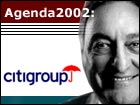
NEW YORK (MONEY Magazine) -
Sanford Weill's life story is straight out of Horatio Alger. The son of Polish immigrants -- his father was a dressmaker, his mother a housewife -- Weill grew up in a second-floor walk-up in the Bensonhurst section of Brooklyn.
A mediocre student, he was eventually shipped off to Peekskill Military Academy, where he improved his grades enough to win acceptance to Cornell University, becoming the first member of his family to earn a college degree.
He married right after graduation, returned to New York and accepted a job as a runner (Wall Street's term for a gofer) at Bear Stearns & Co. He studied for the stockbrokers exam at night, and started to make a name for himself after getting his license.
"It was easy to see he was a winner," onetime colleague Alan "Ace" Greenberg, today Bear Stearns' chairman, once said of Weill.
In 1960, scraping together $200,000 from their personal nest eggs, Weill and four friends decided to open up their own brokerage firm, Carter Berlind & Weill. Fortunately, Weill kept good company.
The friends were Roger Berlind, now the famous Broadway producer; Arthur Carter, now the publisher of the New York Observer newspaper; Marshall Cogan, who later became owner of Manhattan's famous 21 Club restaurant; and Arthur Levitt, future chairman of the Securities and Exchange Commission.
| |
 Also in this series
Also in this series
| |
| | |
| | |
|
But it was Weill who, in 1970, took the lead in transforming their boutique firm, organizing a takeover of Hayden Stone, a big-name broker on the verge of bankruptcy. By today's standards, the deal was akin to Edward Jones acquiring Merrill Lynch. Setting a pattern for future Weill acquisitions, the firm took Hayden Stone's tonier name, eliminated or sold duplicative operations and ended up with considerably more business at minimal additional cost.
Weill repeated the formula, eventually acquiring Shearson Hamill and Loeb Rhoades and renaming the business Shearson Loeb. In 1981 he sold Shearson to American Express for $1 billion, hoping to eventually take charge of the merged entity; four years later, when it became clear that wouldn't happen, he quit.
A year later Weill started down the road that would lead to Citi. He took the reins of Commercial Credit in 1986, and over the next 12 years used pretty much the same game plan he'd perfected at Shearson. He turned Commercial Credit into Smith Barney parent Primerica, and then Primerica into Travelers. Along the way he acquired Salomon Brothers, merging it with Smith Barney.
The piece de resistance, of course, was the Citicorp-Travelers deal. And this time he won a messy power struggle (with Citicorp's John Reed) and emerged as CEO.

|

